Great leadership isn’t just about technical skills—it’s about connecting with your team on a deeper level. Gallup’s research tells us that how leaders interact with their teams directly impacts motivation, engagement, and retention. The message is clear: self-aware leaders who tailor their communication and collaboration strategies can truly connect with their teams and unlock their full potential.
The big question is: Can emotional intelligence be developed through training, or does it solely come from experience and feedback? While you can’t change who people are at their core, you can certainly guide them to better behaviors.
Each leader, team, and organization has its own unique challenges. That’s why one-size-fits-all emotional intelligence training often falls short. Leaders need insights that are tailored to their specific situations and can be applied right away. They need personalized, actionable strategies that make a real difference with the people they’re interacting with in the moment.

Why Personalized Emotional Intelligence Training Matters To Leaders
Traditional training and development efforts certainly have their place, offering valuable insights and skills. However, building self-awareness—a cornerstone of emotional intelligence—requires efforts that are deeply personal and tailored to the individual. Similarly, encouraging leaders to become more attuned to their teams can’t rely on generic team dynamics; it must be focused on their unique team.
Why One-Size-Fits-All Training Falls Short
Personalized training helps leaders apply emotional intelligence concepts in real-world situations. It can empower leaders to focus on areas where they need the most development to strengthen their emotional intelligence and overall effectiveness.
Lack of Practical Application: One-off events or workshops, while engaging, often miss the mark on practical application and continuous action. Leaders might leave with great ideas, but without the means to practice and integrate these new behaviors into their daily routines, the impact is minimal. Emotional intelligence requires time and sustained effort. Real change happens through repeated practice and reflection, which generic workshops simply can’t provide.
Finite Experience: Without ongoing support, even the best workshops remain limited experiences, unlikely to drive lasting development. Emotional intelligence isn’t something you can master in a single session; it’s a continuous journey. Leaders need ongoing, personalized insights that help them apply what they’ve learned in real-world situations, adjusting and refining their approach as they go.
The Need for Personalization
Emotional intelligence requires continuous, personalized learning for individuals to understand their own tendencies and those of others. Training must provide actionable strategies that leaders can integrate into their daily interactions to drive deep, lasting change.
To ensure emotional intelligence training is behavior changing it must go beyond role-based content. It must provide personalized, actionable strategies directly relevant to their responsibilities and the people they work alongside. Only then can Talent Development leaders create the kind of deep, lasting change that makes a real difference for leaders and their teams.

Want To Develop More Emotionally Intelligent Leaders?
Find Out How To Quickly:
- Close the gap between learning and on-the-job application
- Personalize growth to individual strengths and needs
- Integrate learning so it is actually in the flow of work
- Develop human skills fast enough to solve business problems
- Prove the ROI of your development programs

Bring EQ Development To Life with Data-Driven Insights
What if leaders had a personal coach (not a human or chatbot) offering real-time insights tailored to each workday challenge, helping them develop their emotional intelligence seamlessly?
That’s the power of Automated Coaching™. By leveraging data from trusted workplace assessments, it provides ongoing, specific, and practical insights tailored just for you. This approach helps you understand your own behaviors and those of your team, ensuring you can effectively apply emotional intelligence in real-time situations.
Traditional training programs often lack the continuous support necessary for lasting change. Automated Coaching™ fits effortlessly into daily routines, offering valuable insights in just a few minutes each day. This real-time feedback helps leaders immediately apply what they’ve learned, driving meaningful development.
Real-Time Coaching Insights Leads To Immediate Impact
For instance, if you receive an insight that you process information quickly while others need more time, you can adjust your presentation style to be more inclusive. Similarly, a reminder about a team member’s strength can prompt you to involve them in a project where their skills will shine. Discussing these insights in one-on-one meetings can also help delegate tasks effectively and support team growth.
Research supports the effectiveness of continuous, personalized coaching. For example, a meta-analysis published in 2021 found that psychologically informed coaching approaches significantly improve self-awareness, adaptability, and overall workplace performance (Emerald Insight).
Deloitte’s research indicates that coaching in the flow of work, where feedback is integrated into daily activities, enhances the application of insights and leads to more effective performance improvements (Deloitte United States). Josh Bersin also emphasizes that learning in the flow of work allows employees to apply what they learn immediately, making the development process more practical and impactful.
Automated Coaching™ reinvents how leaders develop their emotional intelligence because it provides a more responsive and tailored approach. Insights can be instantly applied to ensure that EQ development is a practical, ongoing journey.

4 Actionable Steps for Leaders To Develop & Practice EQ
Emotional intelligence is not just about understanding your own emotions, but also about recognizing and responding to the emotions of others. Here are some actionable steps to help you grow and apply emotional intelligence within your team.
1. Know and Understand The People On Your Team
Understanding your team members’ preferences is crucial for effective leadership. Instead of overwhelming them with constant questions, observe their interactions and ask occasional, targeted questions to discover their preferred leadership style. Do they thrive with hands-on guidance, or do they prefer autonomy with periodic check-ins? Recognizing these preferences helps tailor your approach to each individual.
2. Craft Personalized Onboarding Experiences For New Hires:
When welcoming new team members, a simple onboarding form can provide valuable insights into their preferences and needs. Consider including questions like:
- Feedback Preferences: How do you like to receive feedback?
- Recognition Comfort: What kind of recognition makes you feel appreciated?
- Motivation Drivers: What motivates you the most?
- Support During Challenges: How would you like to be supported when you’re facing challenges?
- Professional Development: What areas would you like to develop professionally in the next year?
These questions help you tailor your leadership style to each new hire, ensuring a smooth integration into the team and fostering a supportive environment from the start.
3. Encourage Growth Through Meaningful Feedback
Initiate regular one-on-one feedback sessions to foster open communication. This demonstrates your commitment to valuing your team’s input and your dedication to growth as a leader. Tailor your questions to address their specific needs and experiences. Here are a few examples:
- Reflect on Support:Can you share a moment from the past month when my support was most effective for you?
- Identify Additional Needs:What support or resources could I provide that you currently feel are lacking?
- Reduce Overwhelm:Are there any aspects of my support that you find overwhelming or unnecessary?
- Strengthen My Leadership:What is one thing you think I could do differently to better support you as a leader?
4. Embrace Constructive Criticism to Build Trust
Constructive criticism is a powerful tool for growth, but it requires an open mind and patience. By showing your team that you can handle feedback with grace, you set a strong example and build a culture of continuous improvement. Here are some ways to effectively embrace constructive criticism:
- Be An Active Listener:
Give your full attention to the feedback without interrupting. This shows that you respect and value the other person’s perspective. - Reflect Before Reacting:
Take a moment to consider the feedback before responding. This helps you provide thoughtful responses rather than reacting defensively. - Act on Feedback:
Demonstrate your commitment to growth by implementing changes based on the feedback. This shows your team that you value their input and are dedicated to improving. - Close the Loop:
Follow up with the person who gave you the feedback after making changes. This shows that you are committed to continuous improvement and value their contribution.
Scale Team-Wide EQ Development With Automated Coaching™
While these actionable ideas are beneficial, Automated Coaching™ takes leadership development to the next level by tailoring approaches to enhance emotional intelligence (EQ) more effectively. When an entire team uses Cloverleaf, everyone benefits from the personalized insights provided by Automated Coaching™, spreading the responsibility of growth beyond just the leader. This method makes developing the EQ of an entire team both scalable and practical.
Each team member receives unique insights from Automated Coaching™, empowering them to communicate more effectively with their colleagues and leaders. As self-awareness increases individually and collectively, the team’s overall EQ improves, leading to a more harmonious and emotionally intelligent workplace. This shared journey not only strengthens team dynamics but also boosts performance and collaboration across the board.
The Future of Emotionally Intelligent Leadership
Michelle King, PhD, author of How Work Works: The Subtle Science of Getting Ahead Without Losing Yourself (2023), underscores that “75% of career success hinges on advanced social and emotional skills, while only 25% depends on technical know-how.” This makes sense because while technical skills can be acquired, mastering social and emotional skills demands continuous effort and dedication.
Whether you’re an individual contributor or a senior leader, continuously evolving your emotional intelligence is key. Michelle offers several strategies for this evolution, pointing out that “70% of all learning happens on the job.” This highlights the importance of constant, informal development.
This is where Automated Coaching™ steps in. It provides ongoing, personalized learning integrated into your daily work, boosting both self-awareness and the ability to understand others. Automated Coaching™ fits naturally into your routine, delivering timely and relevant insights that help you and your team grow together.
Learning in the flow of work is more than just a buzzword—it’s a transformative concept that, when actually experienced, can truly turn new insights into actual development. We’ve all felt the disruption of stepping away from our daily tasks for a training session or conference. While these traditional methods have value, they often lack immediate applicability.
When learning is truly in the flow of work, it shortens the time between insight and action. The integration of learning moments that are relevant to one’s work into their daily tasks, minimizes interruption. This continuous, contextual learning builds strength, awareness, and encourages a growth-oriented culture. The real impact of learning multiplies when it is actionable because it is timely. Theoretical knowledge can easily be forgotten in the busyness of work, but when learning translates into tangible, value-adding actions, it becomes indispensable.
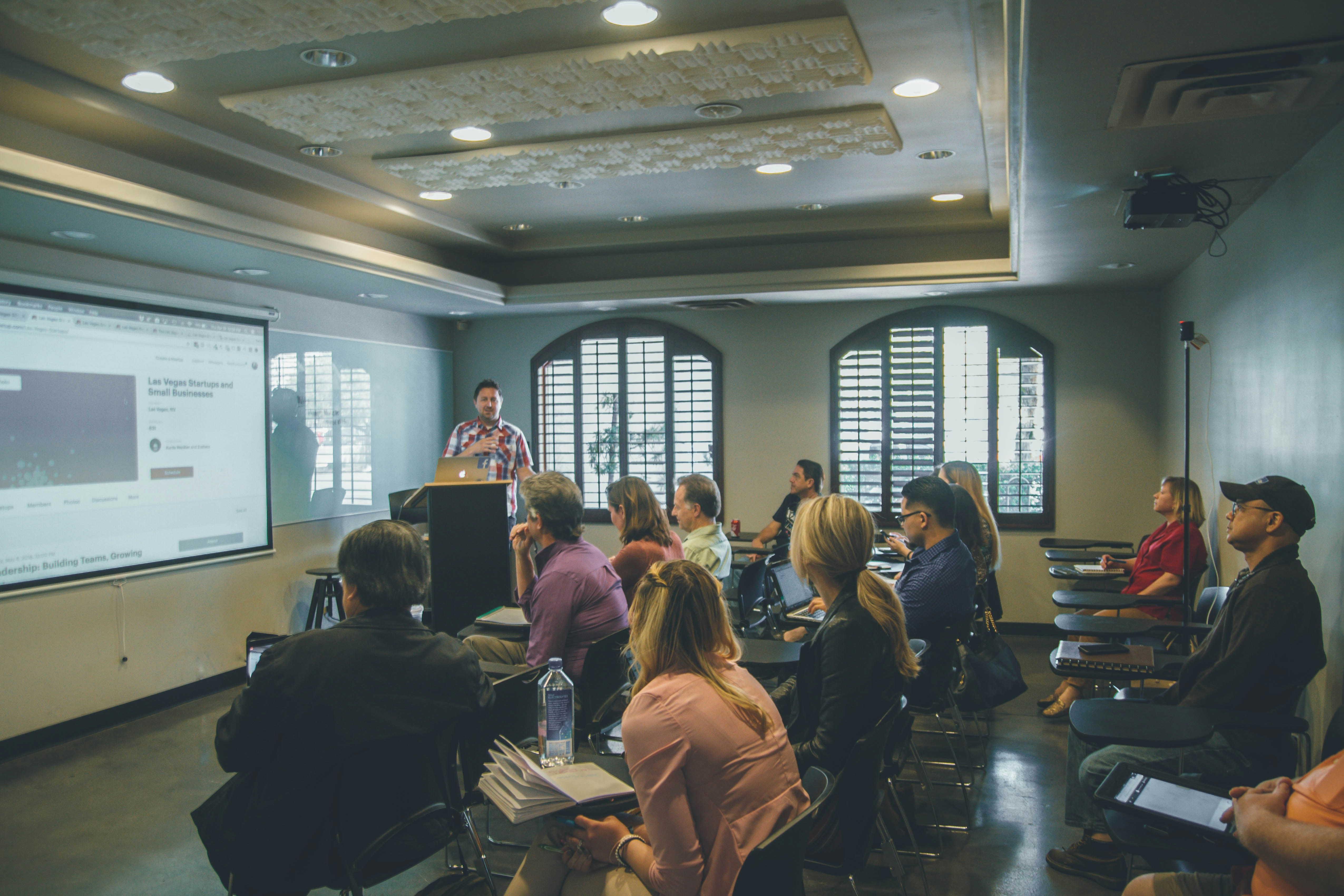
Why Learning In The Flow Of Work Is Still Broken
One of the biggest pitfalls of workplace learning is the misconception that it must be confined to traditional training sessions. In reality, learning can and should take many forms. Offering diverse channels and methods creates an engaging learning environment that resonates with a broader audience.
Consider the dynamics of a live or virtual learning session. Extroverts, thriving on group interactions, often dominate the conversation, actively participating and drawing energy from the experience. In contrast, introverts may find these settings draining, limiting their engagement and the value they derive (Cain, 2018).
Applying practical knowledge from traditional learning can be a significant challenge, especially without structure or accountability. Often, after a training session or course, people return to a mountain of emails and tasks, with catching up becoming their first priority. This scenario can lead to newly acquired knowledge being tucked away into one’s mental filing cabinet, rarely accessed again. This is where Hermann Ebbinghaus’s research on the Forgetting Curve comes into play. He found that people forget about 50% of new information within an hour and up to 90% within a week without reinforcement (Ebbinghaus, 1885). This insight underscores the need for continuous learning and regular reinforcement to make knowledge stick.
Traditional learning also struggles with personalization. While it can provide a broad understanding of topics and strategies, it often fails to meet individual needs effectively. This isn’t to undermine its value—it can spark meaningful discussions, help overcome challenges, and offer a refreshing break from daily routines. However, recognizing its limitations is crucial for evolving our approach and ensuring every learner finds their path to growth and success.
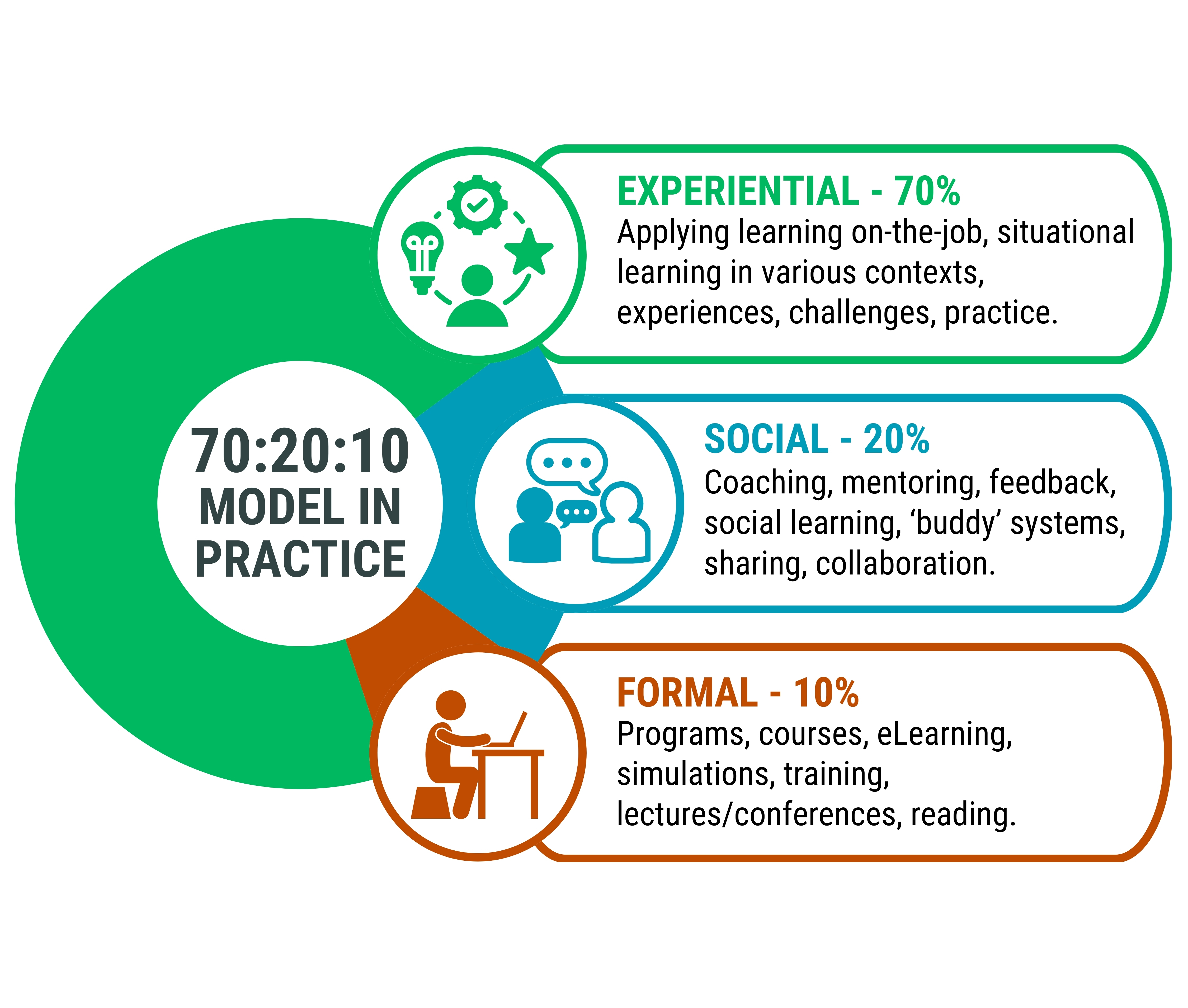
The Disconnect Between Learning and Development
On top of that, the 70-20-10 model of leadership development suggests that 70% of learning comes from on-the-job experiences, 20% from interactions with others, and only 10% from formal educational events (McCall, Lombardo, & Eichinger, 1996). As it turns out, gaining more knowledge is the smallest piece of the growth process. This familiar Talent Development model illustrates that the majority of development happens when
learning is applied in the day-to-day of work.
Learning in the flow of work doesn’t always translate into drag-and-drop self-paced courses or consuming short pieces of content in video or written format. These methods might not be personalized or tailored to individual needs.

HUMAN SKILL PROGRAMS ARE HITTING LIMITATIONS...
5 THINGS THIS FREE RESOURCE WILL TEACH YOU
- Close the widening gap between learning and on-the-job application
- Overcome the tension of pausing productivity for development opportunities
- Integrate learning so it is actually in the flow of work
- The evolution of human skill development
- What Automated Coaching™ is and how it works.

Learning In The Flow Of Work Must BE About The Individual & Their Context
Cloverleaf tackles these challenges head-on by providing personalized learning within the flow of work. This approach minimizes disruption and facilitates the immediate application of practical content, making learning stick. Learning retention increases dramatically when helpful information can be used right away.
For example, consider the power of Automated Coaching™. It requires just 1-2 minutes a day, allowing for quick reflection and application. This consistent source of personalized coaching makes learning concise, meaningful, and specific to their exact work situation. Over time, it builds the muscle of self and team awareness, enabling individuals to communicate and collaborate more effectively based on their natural strengths.
To truly maximize the impact of formal learning, Talent Development leaders need support that only technology makes possible. Human beings can’t possibly scale or provide continuous learning in the flow of work so that people can apply it, but technology-derived micro-nudges certainly can.
Cloverleaf ensures that learning is not just theoretical but practical and immediately relevant. We build Automated Coaching specifically with four pillars that turn learning opportunities into true development for everyone in an organization:
- Personalization
- Scalability
- Continuous Learning
- Proof of Impact
With massive technological advancements, so much is possible today that was implausible a mere 3 years ago. All of the great research on how people work together to create the best outcomes (think: EQ, Human Skills, psychometrics, leadership, collaboration, etc.) can now be partnered with technology to make learning not only possible through small daily moments, but actually attractive and deeply appreciated by people in every level of an organization.
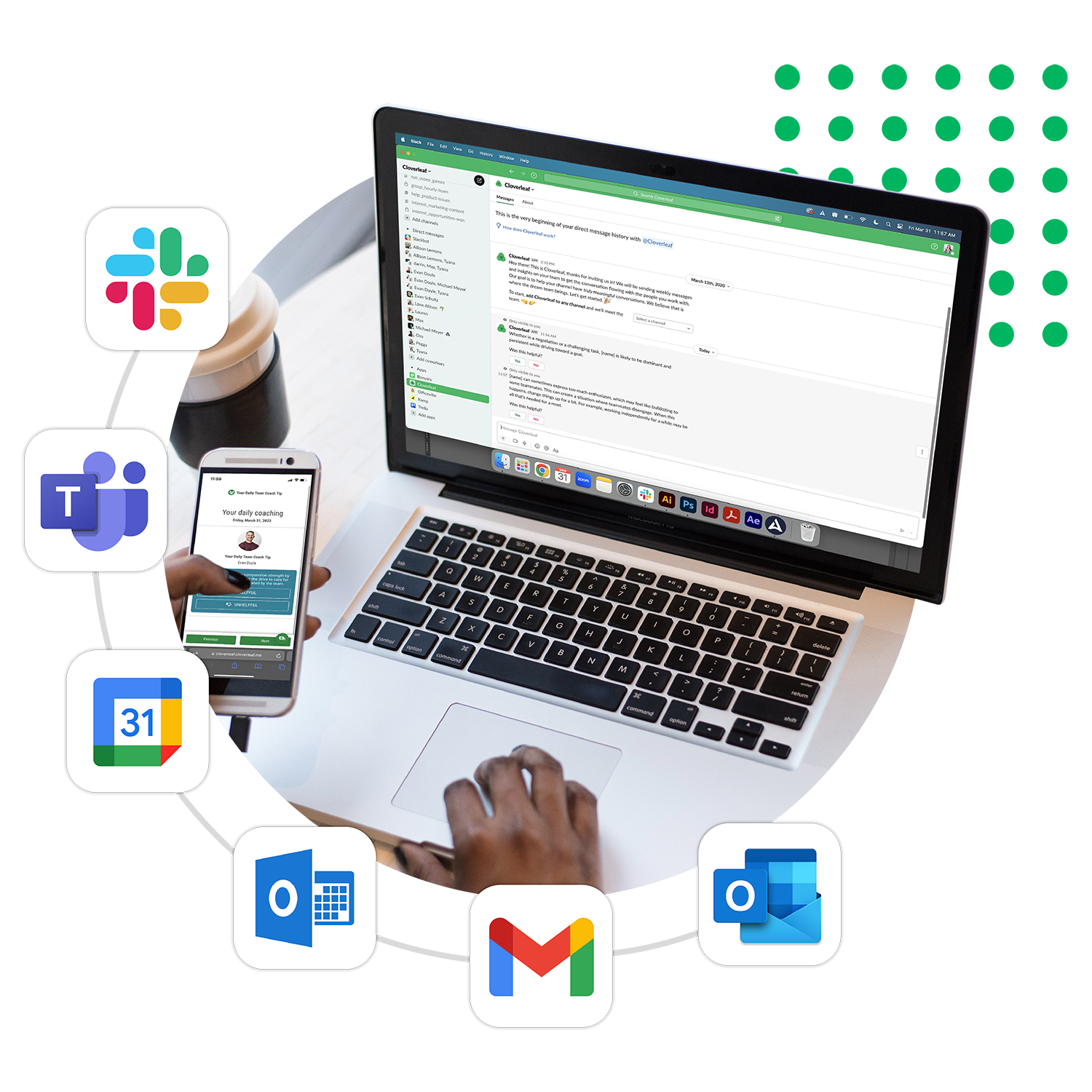
Effortless Learning Inside Your Favorite Tools
One way Cloverleaf makes learning so seamless is through its integration with tools that people already use every day. From email to MS Teams to Slack, Cloverleaf adds an extra dimension of intentionality to your day. As you look at a stacked day of meetings on your calendar, you might think you don’t have time to learn and develop. But by integrating your calendar with Cloverleaf, you’ll receive short, impactful tips about collaborating with who you are meeting, making preparation for conversations simple and personalized.
From Theory to Practice: Cloverleaf’s Impact
Cloverleaf’s Automated Coaching™ can also integrate into existing learning initiatives to help individuals absorb and apply learning to themselves and their teams. In a case study involving over 200 leaders, ranging from the C-Suite to first-time managers, participants learned coaching skills over six months with access to Cloverleaf.
Leaders met every other week for short, impactful coaching skills training and were then tasked with practicing these skills with their teams. Each day, participants engaged with automated coaching tips about themselves and their team members. Here’s how some participants reflected on how Cloverleaf supported their learning journey:
- Cloverleaf’s automated coaching has made me more self-aware of my listening style and how my conflict styles are to avoid potential pitfalls when talking with others.
- Understanding different personality types and how to communicate with them makes a huge difference in my conversations, especially when it comes to conflict.
- Cloverleaf gave me the confidence I needed to address challenging conversations with all the self-tips they gave me.
- By reading my coaching tips daily, it started my day thinking about coaching. I also use the tips about others I interact with to help me in my dealings with them so I find that very helpful.
- Cloverleaf sends me emails each morning with new content each day. I read them every morning and take them into my work day! They’ve been incredibly insightful and provided me with guidance I apply to myself. For example, sometimes I defer to others and their thoughts rather than my own. Cloverleaf reminded me of this and provided guidance on how to find opportunities to give my thoughts!
These reflections from users highlight how Cloverleaf makes a real difference. By including personalized coaching in their daily routines, leaders were able to strengthen their self-awareness, improve communication, and handle challenging conversations with more confidence. This brief snapshot of user experiences indicates individual growth and a more collaborative and effective team environment. The spot-on insights and daily tips ensure that learning is continuous, actionable, and deeply personalized.
The Future of Workplace Learning Is Personalization and Relevance
To stay ahead of the learning curve and effectively develop a multi-generational workforce, learning and people strategy leaders must embrace innovative approaches to integrating learning into the flow of work. This means shifting the focus from broad, generalized content to personalized, relevant learning experiences that cater to diverse needs and preferences.
To stay ahead of the learning curve and effectively develop a multi-generational workforce, learning and people strategy leaders must embrace innovative approaches to integrating learning into the flow of work. This means shifting the focus from broad, generalized content to personalized, relevant learning experiences that cater to diverse needs and preferences.
Today’s workforce includes many individuals who have grown up with technology as an integral part of their educational experience. Traditional learning methods, designed before the digital era, often fail to meet the expectations and habits of this tech-savvy generation. According to the 2024 Workplace Learning Report by LinkedIn Learning, there is a significant shift towards personalized and flexible learning solutions to meet modern employees’ expectations. Therefore, it is crucial to reevaluate learning strategies and ask, How are we addressing the learning needs of today’s workforce?
Providing learning opportunities within the flow of work is becoming increasingly essential, especially in an environment where many teams are hybrid, remote, or dispersed. The Deloitte Insights report on the future of work in technology highlights the importance of integrating continuous learning into daily work processes to keep up with rapid technological advancements and changing workforce dynamics. It emphasizes that learning in the flow of work enhances employee engagement and productivity.
Incorporating learning into the flow of work not only keeps organizations competitive but also supports the growth and success of a diverse and dynamic workforce. It’s time to move beyond traditional learning models and adopt strategies that meet the evolving needs of today’s employees.
For more information about how Automated Coaching is a powerful microlearning tool, download: Talent Development In The Age Of AI: Overcoming the Limitations of Traditional Learning
Corporate learning is experiencing a shift towards more agile and effective training. Google Trends data from the latter part of 2023 reveals a pronounced spike in interest in “microlearning,” a term that has steadily gained prominence since July 2010. This surge in interest reflects a growing recognition among organizations that learners need new ways of accessing and receiving information so that it is easier to retain and apply.
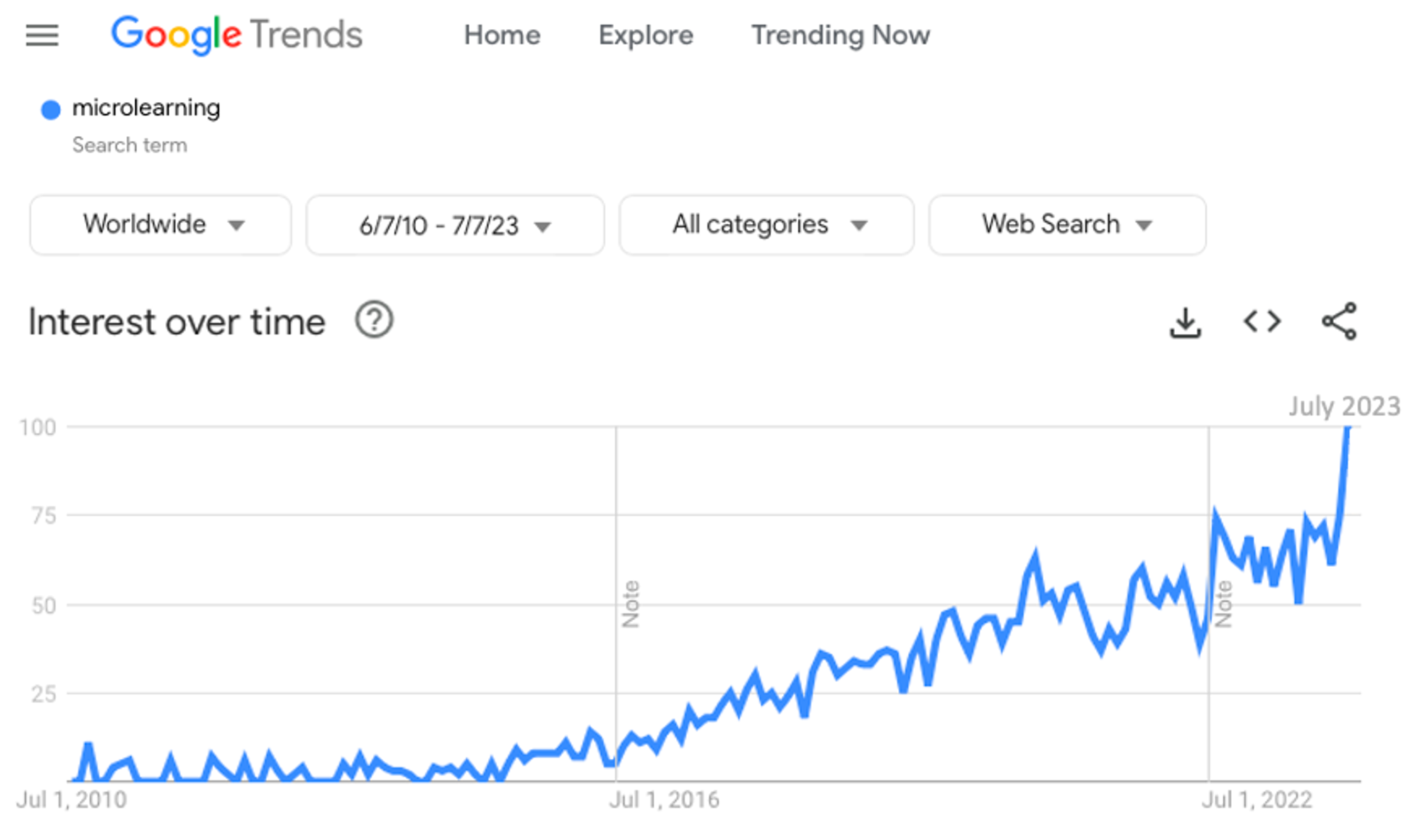
The concept of microlearning is that it is a quick and focused learning experience. Delivering content in small, digestible bursts provides more flexibility for employees with on-demand learning that better integrates into their workflows.
The increase in microlearning signifies more than just a trend; it reflects a strategic pivot in how organizations approach talent development. With technology, platforms have evolved from basic educational tools into integral components of business strategy.
What is Microlearning?
Microlearning revolves around delivering small, digestible content morsels to learners, allowing them to seamlessly integrate learning into their daily workflow. Unlike lengthy training sessions that disrupt office routines, microlearning can be consumed in as little as 3 minutes or as long as 15-20 minutes. By repeating these microlearning moments over time, individuals can effectively learn and internalize concepts relevant to their roles.
Microlearning is not just about short learning sessions; it represents a fundamental shift in the way knowledge is delivered and absorbed in the workplace. It focuses on delivering concise, targeted content in manageable segments.
Why is Microlearning Strategic for Talent Development Leaders
1. Retention and Application: The bite-sized nature of microlearning helps in combat issues like the forgetting curve, as learners engage with key concepts in short, frequent bursts.
2. Adaptability to Changing Needs: Microlearning is flexible by nature and allows learners to access when it is best and most advantageous for them.
3. Learner Engagement: Content that is quick to consume and designed to integrate into a learner’s day makes it easier to digest and more appealing access, particularly among younger employees.
4. Cost-Effectiveness: Reducing time spent away from work and the need for extensive training resources or coaches, microlearning can deliver high-impact learning with less cost.

HUMAN SKILL PROGRAMS ARE HITTING LIMITATIONS...
5 THINGS THIS FREE RESOURCE WILL TEACH YOU
- Close the widening gap between learning and on-the-job application
- Overcome the tension of pausing productivity for development opportunities
- Integrate learning so it is actually in the flow of work
- The evolution of human skill development
- What Automated Coaching™ is and how it works.

Microlearning & Automated Coaching: Personalizing Learning at Scale
Traditionally, microlearning has taken various forms, including short videos, e-learning modules, audio clips, readings, and infographics. While these formats are beneficial, they often lack true personalization that is particularly unique to the individual beyond their role. However, Automated Coaching—a form of microlearning, is tailored content that is highly personalized to individuals and their teams. It is learning that meets you where you are and is about who you are.

AUTOMATED COACHING IS MICROLEARNING THAT ACCELERATES BEHAVIOR CHANGE
Traditionally, microlearning has taken various forms, including short videos, e-learning modules, audio clips, readings, and infographics. While these formats are beneficial, they often lack true personalization that is particularly unique to the individual beyond their role. However, Automated Coaching—a form of microlearning, is tailored content that is highly personalized to individuals and their teams. It is learning that meets you where you are and is about who you are.
How Can Teammates Use Automated Coaching?
Suppose a new team member joins a team, and through automated coaching insights, managers or teammates can learn about their preferred communication style. Equipped with this knowledge, individuals can adjust their own approach to collaborate more effectively with them.
For instance, I might be someone who enthusiastically dives into discussions or meetings without prior planning, whereas my new colleague prefers receiving agendas in advance or starting meetings with an overview of topics to be discussed. As I receive more automated coaching insights about my team members, I can adjust my behavior to enhance collaboration and the results we produce together.
Automated Coaching Is Non-Disruptive By Nature To The Flow of Work
One of the most attractive aspects Automated Coaching is that it actually a microlearning platform. Each insight is designed to be digested in approximately two minutes, making it possible to quickly consume and reflect upon without breaking the flow of your workday. This relevancy to both individual and team contexts means that insights can immediately spark thoughts or actions that enhance daily productivity.
A Microlearning Platform That Creates A Proactive Workday:
Starting one’s day by receiving automated coaching insights encourages a proactive approach to tasks and opportunities for collaboration. People can’t possibly remember everything about all of their team members every day or even have all of their own strengths top of mind. Automating the process helps keep critical information about dynamics with teammates and personal strengths at the forefront to influence better decision-making and interaction throughout the day.
Reduce Disruption So That Learning Is Seamless:
Unlike other microlearning platforms that might require setting aside dedicated or extended time for consumption, Automated Coaching is accessible and on demand. It is done-for-you learning that does not require the learner to listen to anything or even complete an action. Whether you need a quick tip before a meeting or a reminder about a team member’s communication style, it’s available right when you need it, integrating seamlessly into your workflow.
Dual-Direction Accessibility:
The great part about Automated Coaching is that it can be pushed out to you and pulled towards you. It is nudge learning that comes to you and is also at your fingertips anytime you need it. This feature allows for customizing personalized preparation, which is especially useful in strategizing for upcoming interactions or feedback sessions.
Relevant Learning That Impacts Culture:
The ongoing, dynamic personalization of Automated Coaching ensures that learning is relevant and useful and continuously lives as a creative resource to support ongoing self and team awareness. As individuals take intentional action resulting from engagement with Automated Coaching, it can lead to a positive domino effect on team cohesion and culture.
Maximizing Microlearning Platforms For Engagement, Knowledge Retention & Integration
Easy, quick learning that provides value, makes repeating small acts attainable for people, and will lead to higher learning potential. This is not to say that live or virtual training can’t be valuable for team building or even changing up the environment, but for longer-term knowledge retention, much of what people learn in a finite training session is quickly forgotten.
This is also known as The Forgetting Curve. Within 1 hour, people forget 50% of new information. Within 1 day, they have forgotten 70%. Within 1 week, they have forgotten 90% of what they learned. This means more frequent touchpoints that are personalized and bite-size can have a much greater impact on learning retention.
One of the most valuable aspects of Automated Coaching is that it’s not an LMS. Instead, coaching insights can be delivered through tools people are already familiar with and using every day. This microlearning approach is different because it truly embeds the learning in the flow of work and enables people to remain in the context to apply the learning over time.
Reinforce Training with Little Lift
An advantage of Automated Coaching is that it does not require any development or the work of an Instructional Designer. Automated Coaching is “done for you” microlearning that can greatly impact productivity, collaboration, soft (essential) skill development, communication, and self/team development.
People and learning leaders can be confident knowing that microlearning people take action on is at the fingertips of their leaders, managers, and teams.
For learning and development leaders, utilizing microlearning means embracing a future where development is continuous, personalized, scalable, and aligned with strategic business goals. With microlearning platforms, the goal is not just to provide information but to ensure that learning translates into positive action.
For more information about how Automated Coaching is a powerful microlearning tool, download: Talent Development In The Age Of AI: Overcoming the Limitations of Traditional Learning
Talent Development Leaders play an essential role in helping their team develop soft skills (human skills) by sharing time-testing learning and concepts. This information provides foundational knowledge and skills that are essential for employee growth. However, one of the ongoing challenges in learning and development is ensuring that the valuable insights gained from these sessions are retained and effectively applied in everyday work.
We have access to more information than ever before, yet the changing nature of work, pressing problems to solve, and focus on productivity can quickly outpace the ability to retain new learning. Even before these more modern challenges made it harder to focus and acquire knowledge, there were models about learning that showed a typical erosion of knowledge days after learning. The human mind can only process a limited amount of information, most of which never makes it to long-term memory.
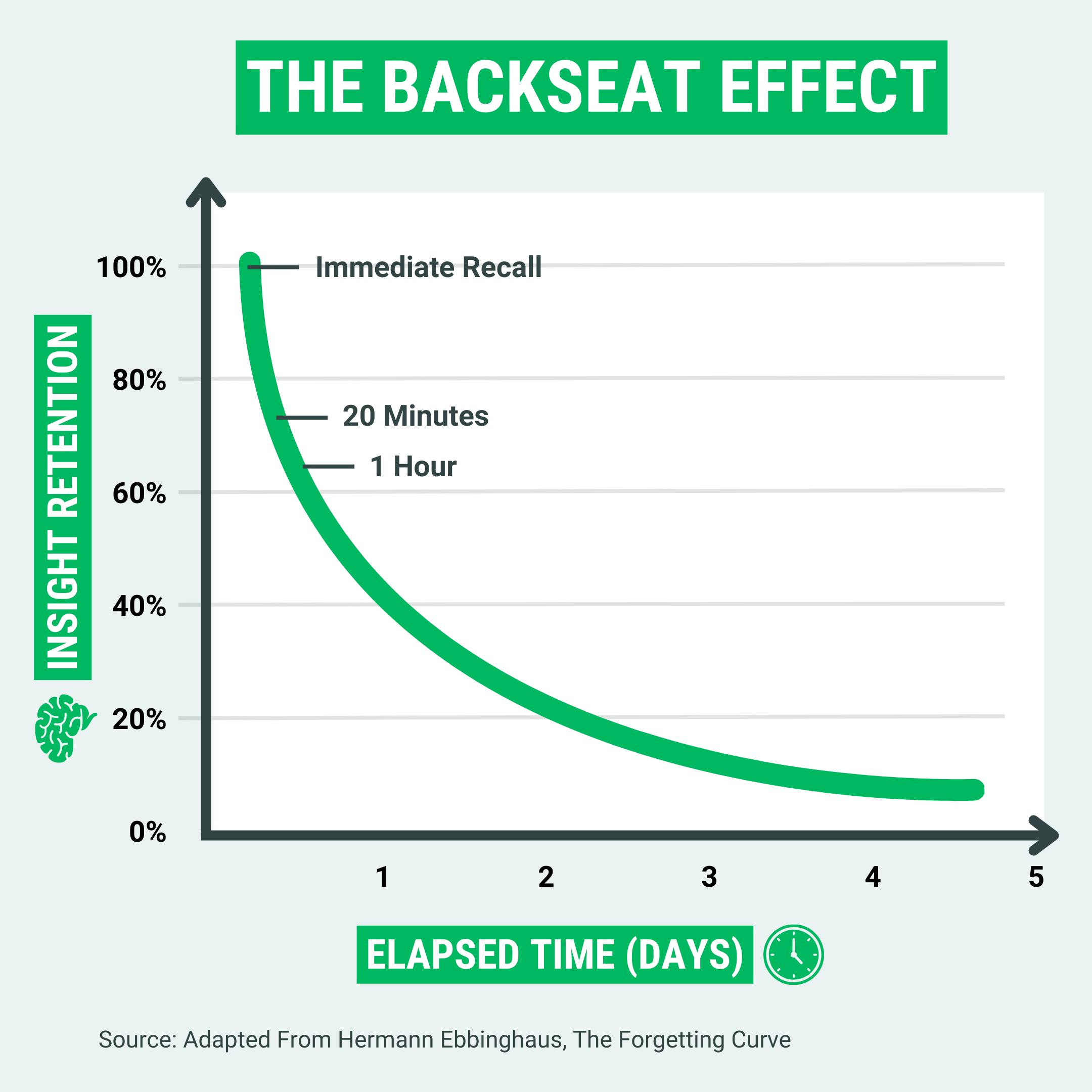
Does Learning and Development Need To Adapt?
Learning methods provide so much valuable information, but how do you make it stick? Training often involves ongoing sessions, but what about when these are not available or happening? Learners may forget or struggle to apply.
This was famously measured and proven by one of the most influential early experiments in psychology. Between 1880 and 1885, Hermann Ebbinghaus studied how much information can be retained after specific intervals of time. He found that within 20 minutes of studying new information, 40% is already forgotten, rising to nearly 70% by the end of that first day (Murre & Dros, 2015). This study has since been replicated numerous times, all with similar results, and that is after studying information with intentional attempts to remember it.
The approach to development is ripe for change so that it can align with how our brains process and retain information.
Enter the concept of micro-nudges, an approach to learning and development that seamlessly integrates into the daily workflow of employees. Micro-nudges are brief, focused prompts that facilitate continuous learning and improvement without the cognitive overload associated with traditional methods.
Nudges can leverage contextual, situational prompts to encourage behaviors and actions that align with organizational goals and individual development paths. Providing small, digestible pieces of information right when they are most relevant enables a more natural and effective understanding and application of new knowledge.

HUMAN SKILL PROGRAMS ARE HITTING LIMITATIONS...
5 THINGS THIS FREE RESOURCE WILL TEACH YOU
- Close the widening gap between learning and on-the-job application
- Overcome the tension of pausing productivity for development opportunities
- Integrate learning so it is actually in the flow of work
- The evolution of human skill development
- What Automated Coaching™ is and how it works.

Why Are Micro Nudges More Effective For Employees?
Micro-nudges represent a tailored solution to the challenges traditionally associated with learning and development, particularly the problems of information overload and rapid forgetfulness post-training. By addressing these issues head-on, micro-nudges enhance the learning experience, making it more effective and impactful.
Consider what it’s like to use some of the most popular strengths and behavioral assessments such as Myers-Briggs®, DISC, CliftonStrengths®, or Enneagram. Most assessment results are delivered as an overwhelming, one-time data dump in the form of a 30-page PDF report.
Most people will say they gleaned a key epiphany about themselves but can’t remember their result type. One epiphany is helpful, but 99% of the value is lost.
This happens so often that the trade has a nickname for this problem—the backseat effect—whereby detailed assessment reports are never fully internalized and tossed into the backseat of one’s car. Not because the reports aren’t thoughtfully constructed or lack insight but because they are simply too much information to handle at once.
A better approach entails using automated micro-nudges, where actionable insights are delivered in small doses over a long period of time. For example, Automated Coaching™ uses this approach by delivering assessment-derived recommendations via organizational communication channels (e.g., email, Slack, Teams) on how employees should approach their tasks or interactions with teammates.
Nudges can transform hard-to-retain information into an integrated learning process that aligns with the principles of how people best learn and adapt.

Are Nudges The Solution To The Challenges Of Human Skill Development?
1. Soft Skill Development Is A Dynamic Process
There is an assumption that soft skill development is sequential and upward, whereby individuals start at a lower level of competency and progress towards a pinnacle destination. While this scaffolding approach works for technical skills, it breaks down for soft skills.
The process of soft skill development is fluid—you start in situ, with varying levels of competence across an ever-evolving list of knowledge, skills, and abilities that matter in some contexts but not others (Day & Dragoni, 2015). Therefore, when it comes to developing human skills, it must move from a static experience to a dynamic experience.
Nudges provide timely, situational guidance that allows individuals to apply and refine these skills in real-time, adapting to the evolving demands of different workplace scenarios.
2. Soft Skill Development Must Be Highly Personalized
Organizations typically approach soft skill initiatives as if everyone is similar with respect to their psychographics (e.g., traits, strengths, cognitive abilities, worldviews, etc.) and their interest in development in general (e.g., motivation to learn, leader identity, self-efficacy). While designing for the mean is efficient, it’s not effective. The goal, instead, should be to assume variability across individuals (Rose et al., 2013) and, in turn, move from overgeneralized insights to personalized insights.
For example, Automated Coaching counters this problem by offering personalized insights tailored to the unique psychographics of each individual, such as their traits, strengths, and cognitive abilities. By integrating data-driven insights into personalized nudges, learners receive specific, relevant guidance that respects their individual differences and developmental needs.
3. Soft Skill Development Must Be Actionable
Soft skill development typically happens as a one-time initiative (e.g., workshop, training, coaching session, etc.) where participants are inundated with recommendations. This approach is misaligned with information processing theory, which suggests that human beings can only process and retain a limited amount of information in one setting (Atkinson & Shiffrin, 1968).
Nudges address this challenge by breaking down information into smaller, manageable insights delivered at the point of need. To fully optimize developmental resources (e.g., time, money, energy) necessitates an approach that moves from being overwhelming to one that is digestible and actionable.
Nudges Can Make Human Skill Development A Light Lift For Leaders
In total, the problem is that soft skill development is currently a static, overgeneralized, and overwhelming experience but should instead be a dynamic, personalized, and actionable experience.
Micro-nudges are promising given that research suggests that learning and behavior regulation are optimized when the experience is customized to individuals’ characteristics and needs, situationally adaptive, integrated within one’s flow of work, and available on demand (Maity, 2019). Human beings can’t accommodate these features at scale, but technology-derived micro-nudges certainly can (Kurzweil, 1990).
Those in charge of assessments need to be realistic. People can’t internalize information like super-computers. The goal should be to deliver digestible nuggets of information at the right time and in the right place. Addressing individuals’ specific needs and contexts, micro-nudges help transform the approach to soft skill development from a burdensome task into a series of manageable, impactful interactions that promote sustainable growth and meaningful engagement in the workplace.
Proven Behavior Change Through Coaching Nudges
One of the most compelling validations for the use of micro-nudges in talent development comes from recent research findings associated with Automated Coaching™. Studies have shown that micro-nudges significantly boost self-reflection, enhance the desire for self-knowledge, and improve the capability to handle complex challenges.
Impact on Self-Reflection and Self-Knowledge: Micro-nudges are specifically designed to prompt individuals to think critically about their immediate actions and how these align with their longer-term goals and professional growth. This continual engagement not only reinforces learning but also fosters a deeper understanding of one’s strengths and areas for improvement.
Enhancing Capability to Handle Challenges: By providing real-time, contextual feedback, micro-nudges empower employees to apply soft skills in various situations, from resolving conflicts to collaborating effectively with diverse teams.
Contextualized Nudges Make Scaling Human Skills A Real Possibility
One of the most significant advantages of micro-nudges is their ability to provide real-time, contextualized feedback. This type of feedback is crucial because it ties directly into the immediate tasks or challenges employees face. By integrating learning directly into the flow of work, micro-nudges ensure that training is not only more relevant but also immediately applicable.
Moreover, micro-nudges allow for a dynamic learning experience that evolves with the needs of the employee. Automated Coaching is designed to deliver information in a way that the human brain best processes and retains data: little by little and just at the right time.
The effectiveness of micro-nudges is also evident in their capacity to encourage behaviors and actions that align with organizational goals and individual development paths. By providing small, digestible pieces of information at critical moments, micro-nudges enable a more natural and effective understanding and application of knowledge, which is vital for personal growth and organizational success.
The role of Learning and Development (L&D) is undergoing a significant transformation. No longer just a support function, L&D is becoming a critical strategic partner, essential for navigating the complexities of today’s workforce. During a recent webinar hosted by Cloverleaf, industry experts discussed these changes, addressing both the challenges and innovative solutions within modern L&D practices.
During the webinar, Stephanie Licata, Senior Learning Strategist at Cloverleaf, framed the discussion: “We’re really here to talk about how do we transform how L&D is perceived, how it’s leveraged, how we think about it, how stakeholders think about it, and how we can really help organizations leverage it as that competitive edge.”
This statement underscores the evolving perception of L&D from a cost center to a catalyst for organizational success. The discussion highlighted the critical nature of integrating L&D strategies seamlessly into business operations, emphasizing that effective L&D practices can significantly influence a company’s competitive position by enhancing workforce capabilities and fostering a culture of continuous improvement and innovation.
In this post, we explore key insights that are shifting the perception of L&D’s role and examine how to transform learning and development into a powerful lever for business growth and employee development.

L&D Can Be A Strategic Investment Not A Cost Center For Organizations
L&D is transitioning from its traditional training function to a strategic investment within organizations. L&D needs to be seen not just as a training ground but as a pivotal engine driving the business forward. This evolution reflects a broader recognition of L&D’s potential to not only improve individual performance but also to drive organizational growth and adaptability.
Another significant takeaway is the integration of L&D into the very fabric of company culture. By making learning a core aspect of organizational life, companies can unlock the full potential of their employees. This integration helps in cultivating a workforce that is continuously evolving, adaptable, and aligned with the company’s long-term strategic goals. When L&D is woven into daily operations, it becomes a natural part of progress.
Automated Coaching™ supports this perspective because it embeds learning into the very fabric of one’s work, ensuring that L&D initiatives are directly tied to achieving business goals.
You’ve probably built and bought tons of content, but translating it all to your team, particularly managers can be challenging. Automated Coaching™ provides real-time support: just start asking questions… ‘How do I resolve conflict with [name]?’ and receive instant, personalized advice to navigate challenging moments. Leaders need more effective ways to ensure that the valuable information shared during training sessions becomes applicable and available at the moment it is needed, specific to a team member’s context. Automated coaching does this.

HUMAN SKILL PROGRAMS ARE HITTING LIMITATIONS...
5 THINGS THIS FREE RESOURCE WILL TEACH YOU
- Close the widening gap between learning and on-the-job application
- Overcome the tension of pausing productivity for development opportunities
- Integrate learning so it is actually in the flow of work
- The evolution of human skill development
- What Automated Coaching™ is and how it works.
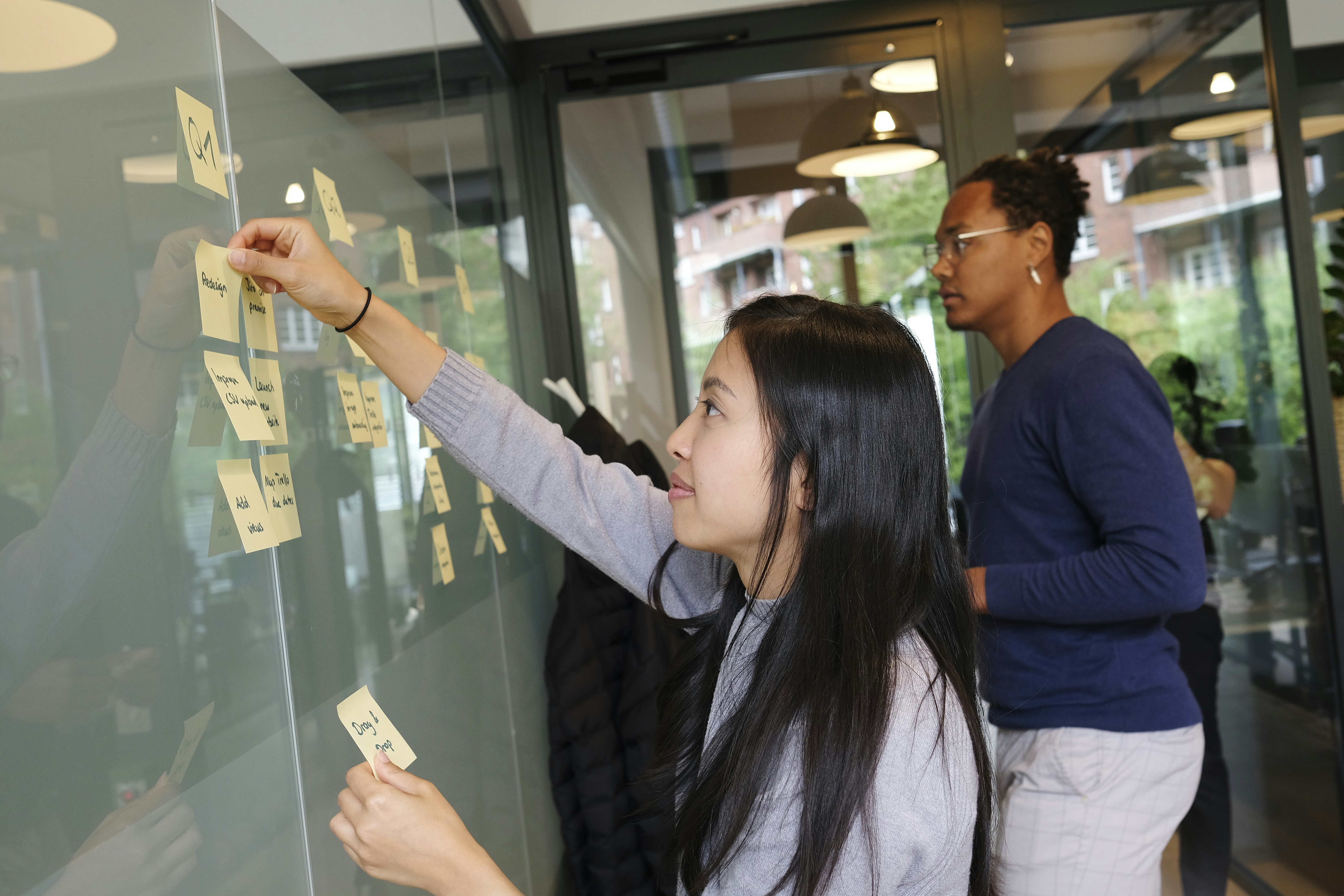
3 Significant Challenges in Traditional L&D Approaches
The traditional “one-size-fits-all” model of L&D often fails to address the diverse needs of each employee, leading to suboptimal outcomes and wasted resources. A lack of personalization and scalability in conventional learning programs can significantly hinder their effectiveness and impact. Current methods often fall short due to several inherent limitations:
1. Lack of Personalization Traditional training programs often employ one-size-fits-all approaches because development leaders simply cannot be everywhere at once or provide content that is unique for each person and specific to their context.
2. Limited Scalability As organizations grow and become more global, scaling L&D initiatives to meet diverse and evolving needs becomes increasingly challenging without the right technology and strategy in place. Not to mention, development becomes costly when you consider providing it beyond a small group of leaders.
3. Loss Of Relevancy If training is confined to specific times or opportunities it loses relevancy. Learning and development must be accessible so that it is not dependent upon schedules and can happen in the flow of work.
L&D must move beyond traditional training methods that always requires removing people and overloading them with content and instead look at ways to embed learning directly into the flow of work.
Cloverleaf’s Response to these L&D Challenges
Business leaders keep asking learning professionals the same questions over the years.
Are we getting good value from investment in training?
Which type of training is the most effective?
How can we improve current learning and development programs?
What additional learning support do our teams need?
To answer these recurring questions, leaders need data that reveals the tangible impact of your L&D initiatives to demonstrate how tailored learning strategies can deliver measurable improvements in employee performance, organizational efficiency, and ROI.

Contextual Microlearning
Cloverleaf challenges the traditional “one-size-fits-all” approach by focusing on personalized microlearning that is available and according to what an individual needs. Integrating learning into daily workflows helps ensure that it’s not only relevant but also perfectly timed to meet immediate business challenges. This means every learning instance is directly beneficial.
Automated Coaching Scales
Automated Coaching technology transforms coaching into a resource accessible for all employees, not just executives. It democratizes the learning process, making it possible to extend personalized coaching across entire organizations, regardless of geographical and functional barriers.
Continuous Learning Embedded in the Flow of Work
Embedding learning directly into the workflow, ensures that it becomes a seamless aspect of one’s daily activities. Sporadic or even scheduled training sessions struggle to make learning actionable; Automated Coaching integrates learning with the work itself, making it continuous and immediate. Doing so significantly enhances the agility and responsiveness of our workforce.
Proof of Impact
Cloverleaf helps reinforce this approach by using data to measure the effectiveness of learning interventions. In addition to metrics like completion surveys, it’s about capturing data that truly matters to businesses, such as improvements in behavior and job performance that deliver tangible impact on business results.
Forward-thinking organizations need to create environments that embrace and unlock the potential of the whole employee. Doing so requires embedding L&D into the fabric of the culture, transforming learning from a peripheral activity into a core strategic asset. During the Cloverleaf webinar, insights were shared on how effectively this can be achieved.
Weaving L&D into Company Culture with Cloverleaf
Organizations must create environments that express the intention to embrace and unlock the potential of the whole employee. People are not their roles. People are not their titles. People are not their skills. People are not their assessment results. They are whole human beings.
This perspective underscores the need for a holistic approach to employee development, one that goes beyond traditional training and development methods. Kim Crean, a panelist during the webinar, emphasized the strategic role of L&D in shaping company culture:
The most effective strategy that I’ve had in any organization is challenging our leadership to consider L&D as their partner. So I consider it like a hub and spoke kind of situation. L&D being the hub and the spoke driving to all those various strategies, either business priorities or workforce transformation, Crean explained.
This approach is not only about including L&D in the strategic conversation but making it a central part of how the company operates day-to-day. Crean further elaborated on how this integration happens in practice:
Typically, what I’ve done in many organizations is a listening tour of what we currently have and if there is something that we can either repurpose or reuse. This is the time it’s going to take for us to make that happen. Then these are the steps and skills that we’re going to get out of it. So, really being able to have a full training needs analysis of what it is that we need so that we can be engaged with our senior leaders on why we are not just a cost center. We are not just here to support you, but really partner with you on what you need today, what you need for your future.
The strategic placement of L&D within company culture has transformative effects. By weaving learning directly into the operations, it ensures it’s not just an afterthought but a fundamental component of our strategy. This integration enables a culture where continuous improvement is the norm, not the exception. Crean’s insights highlight the importance of viewing L&D as an integral business partner, shaping a culture of continuous development and readiness for future challenges.
Maintaining Agility and Responsiveness with Learning Solutions
To stay agile and responsive when the market changes, when economic shifts and technology comes on and changes everything, L&D can be this seed that you plant while creating the right environment around it for it to sprout and flourish and produce fruit in time, another panelist, Sotus Pulimenos a Global Talent Best Practices Leader stated. The key is to have learning professionals in the right positions to proactively bridge gaps and be forward-thinking in their approach to workforce development.
It’s about embedding learning and development so deeply that it becomes a part of the regular business rhythm and not something that Talent Leaders scramble to update or adapt when external pressures demand it.
Unlike traditional L&D programs that pull employees out of their work environment, Cloverleaf ensures learning is part of the daily routine. This method eliminates the common disconnect between learning and application, making development ongoing and directly relevant to each individual’s tasks and challenges. Automated Coaching empowers employees to apply learning in real-time, so that learning has a direct impact on their current projects and challenges.
Empowering L&D to Drive Strategic Impact Today
Transforming Learning and Development from a peripheral support function to a central strategic asset requires a profound shift in how L&D is perceived and implemented within organizations. Progressive leaders recognize that L&D is a pivotal force in driving business growth because of its ability to strengthen employee competencies that actually impact organizational success.
Using data-driven learning through Automated Coaching ensures that L&D initiatives are both impactful and directly tied to the real-time business needs of people, helping keep the workforce agile and responsive to the dynamics in the workplace that accelerate or slow work.
By redefining the role of L&D and embedding it deeply within company culture, organizations can better prepare for the complexities of working together and draw out the full potential of their human resources.
Imagine a workplace where every conversation sparks innovation, where every team meeting leaves you feeling more energized than drained. It’s not just a daydream; it’s the potential reality of a team that understands the profound interplay of personality types and practices the art of conflict resolution. This isn’t about lofty ideals but a practical roadmap to transforming everyday interactions into building blocks for a thriving organizational culture.
In this post, Stephanie Licata and Peggy Murriner, experts in organizational behavior and personality analysis, detail the core of effective teamwork. Through their unique lens, they unravel the complexities of human dynamics in professional settings, offering insights that turn potential workplace conflicts into opportunities for unparalleled growth and collaboration.
Too often, organizations focus merely on the functional role and hope that good team performance somehow follows. This is why even the most expensive professional sports teams often fail to perform according to the individual talents of each player: There is no psychological synergy. A more effective approach (like the mission to Mars example) focuses as much on people’s personalities as on their skills,’ highlighting the critical need for considering personality dynamics within teams. – Harvard Business Review
Stephanie’s expertise in the subtleties of team dynamics converges with Peggy’s innovative approach to personality frameworks. Together, they present a fusion of ideas that will challenge your perceptions, equip you with practical strategies, and inspire a new way of thinking about team interactions.
Whether you’re leading a diverse team, striving to find your place in a complex work environment, or simply curious about the psychological underpinnings of workplace relationships, this conversation is for you.
So, let’s uncover the secrets to working together and excelling in a workplace where every personality type is a valuable piece of the puzzle that can contribute meaningfully to the team.

Decoding Workplace Personality Conflicts: Beyond the Surface Interactions
Team dynamics are often like an iceberg – what we see on the surface is just a fraction of the complex interplay beneath. Unearthing the subtle yet critical aspects of these dynamics is possible by understanding the nuanced differences between conflict perception and the realities of challenging, constructive dialogues in a team setting.
The Nature of Conflict in Teams:
- Perception vs. Reality of Conflict: Stephanie Licata sheds light on a common misconception: Sometimes we perceive that something is going to be a conflict but it’s really just a difficult conversation. It’s a challenging conversation, right? This distinction is crucial in team dynamics, as it differentiates between unproductive personal disputes and the constructive challenges essential for progress.
- Healthy Conflict as a Growth Catalyst: Peggy Murriner observes, The highest performing teams actually allow themselves to engage in healthy conflict. Task conflict, as opposed to personal conflict, can be a powerful tool for team innovation and problem-solving. Adopting this perspective emphasizes that conflict isn’t an obstacle but a driving force for creativity and improvement when managed correctly.
In understanding the nature of conflict within teams, it’s insightful to consider broader workplace trends. According to the Niagara Institute, the most common conflict management style is collaboration, used by 59.8% of professionals, followed by compromise at 24.4%. Interestingly, more confrontational styles like competing, avoiding, and accommodating are less frequently employed.
75% of employees believe their direct manager could handle workplace conflicts better. Moreover, 60% of HR professionals attribute workplace conflicts to poor management. On a positive note, 95% of those who receive conflict resolution training report an improved work environment, underscoring the value of such training.
Leaders and teammates must realize that personal experiences of conflict can heavily influence team dynamics. Understanding that these stories exist and everyone has a personal narrative can help people effectively navigate conflict with empathy.
The Role of Preparation and Individual Conflict Styles:
Being proactive and understanding the unique conflict styles of each person is vital. It’s about striking the right balance between engagement and resolution, ensuring all discussions, no matter how challenging, are geared towards the team’s collective goals.

HUMAN SKILL PROGRAMS ARE HITTING LIMITATIONS...
5 THINGS THIS FREE RESOURCE WILL TEACH YOU
- Close the widening gap between learning and on-the-job application
- Overcome the tension of pausing productivity for development opportunities
- Integrate learning so it is actually in the flow of work
- The evolution of human skill development
- What Automated Coaching™ is and how it works.

The Role of Personality Types in Conflict Resolution
Have you ever wondered why some team disagreements fuel creativity while others end in stalemate?” This question lies at the heart of exploring how personality types shape conflict resolution within teams.
Understanding the intricate role of personality types in conflict is essential for fostering effective team dynamics. Each team member brings a unique approach to handling conflicts, shaped by their inherent personality traits and different perspectives.
Unpacking Personality Dynamics in Conflicts:
Healthy conflict, focused on tasks rather than personal differences, can be a catalyst for a team’s innovative solutions and problem-solving. Successfully managing conflict requires differentiating between personal animosities and constructive debate.
What we often anticipate as a looming conflict is frequently just a necessary, albeit challenging, conversation. – Stephanie Licata
Leaders who acknowledge this insight can better influence how their team approaches what initially appears as conflicts, transforming them into opportunities for open communication and growth.
Leveraging Personality Assessments:
Tools like the 16 Types, DISC, and Enneagram provide a framework for understanding teammates. These assets are not just about categorizing personalities but about gaining deeper insights into how different individuals approach conflict and collaboration. The insights from these tools can be transformative in crafting strategies that play to each team member’s strengths and preferences.
4 Strategies for Navigating Conflicts Between Different Personalities:
- Identify and Adapt to Individual Conflict Styles: Begin by assessing each team member’s preferred style of handling conflict (using tools like DISC or the Enneagram). Then, tailor your approach accordingly. For example, if an individual appreciates directness, address issues head-on with them. If another prefers to avoid conflict, find ways to engage them in dialogue, ensuring their perspective is heard without causing discomfort.
- Promote Constructive Conflict for Innovation: Create a team culture where task-related conflicts are not seen as hurdles but as opportunities for innovation. Celebrate when individuals voice differing opinions on tasks or projects and facilitate these discussions in a structured way.
- Practice Empathy: Develop empathy by seeking to understand each team member’s background and how it shapes their approach to conflict. Use regular one-on-one meetings to understand their perspectives and fears.
- Balance Dialogue and Team Goals: Ensure that all discussions, even when they diverge into conflict, are aligned with the team’s overarching goals. Set clear agendas for meetings where potential conflicts may arise and remind teammates of the common objectives. Facilitate discussions so that the viewpoint of conflicting parties is connected to how it helps or hinders the team’s progress toward these goals.
Managing conflict in the workplace involves a nuanced interplay between understanding and action. It’s about recognizing the fine line between disruptive conflict and healthy debate to harness the latter to nurture an environment where diverse opinions and styles coexist and work together to drive the team forward.

The Key to Effective Communication Among Diverse Personalities Within Teams
Within diverse teams, varied communication styles can often lead to misunderstandings or poor communication. However, by acknowledging and celebrating the diversity in how individuals communicate, teams can unlock more depth in their interactions to create more inclusive and effective teamwork.
Recognizing that there is a spectrum of communication styles and valuing each member’s unique approach can bring a new level of understanding and cohesion, turning potential discord into an opportunity for richer, more inclusive discussions.
In a team, every voice matters. Encouraging and valuing diverse perspectives enriches the conversation and leads to more innovative solutions. – Stephanie Licata.
When teammates truly understand and adapt to the various ways of communicating, what they see as simple conversations can evolve into powerful collaboration tools for untapped potential.
4 Ways To Experience Effective Communication Between Different Personalities
1. Cultivate a Culture of Active Listening: Fully engage with those speaking, try to understand their point of view, and respond thoughtfully. This practice helps ensure all ideas are considered and valued and minimizes miscommunication.
2. Empathy and Emotional Intelligence: Emotional intelligence is a cornerstone of effective team communication. Understanding and responding to the emotional context of communications can create more empathetic and effective exchanges.
3. Regular Feedback and Check-ins: Establish regular feedback and check-ins to maintain open lines of communication within the team. Regular team meetings and one-on-one sessions offer a platform to address concerns, share successes, and reinforce a culture of positive communication.
4. Utilize Communication Tools: Leveraging personality assessments is invaluable in understanding and enhancing team communication. Many tools offer profound insights into a person’s unique way of interacting, work styles, sharing ideas, and receiving feedback.
Dissolving Personality Clashes With Cloverleaf's Insightful Coaching
One of the most effective ways Cloverleaf aids teams is by using personality data from tools like the 16 Types, DISC, and Enneagram to provide Automated Coaching™. These layered insights allow teams to illuminate the diverse ways individuals may engage in different types of conflict and communication. Leveraging this understanding can transform personality issues into a foundation for stronger, more resilient team dynamics.
Given the statistics on conflict management styles and their impact on employees, Cloverleaf’s tools become even more essential. They offer innovative ways to understand and address these challenges, aligning with the preference for collaboration and reducing the negative impacts of conflict.
Embracing a Future of Teamwork Shaped By Self and Other Awareness
The key to unlocking a team’s full potential lies in embracing the diversity of personalities, understanding the true nature of conflict, and harnessing the power of empathetic communication. By adopting these insights, teams can transform challenges into opportunities for growth and innovation.
The future of teamwork is not just about individual competence but about creating psychological safety, where each member’s unique traits and perspectives are valued and integrated into a collective force. It’s about moving beyond the conventional and stepping into a world where every interaction is a chance to learn, grow, and excel together.
We hope you take these lessons to heart, apply them within your teams, and experience the transformation firsthand. If you haven’t already, explore Cloverleaf’s suite of tools to gain deeper insights into your team’s dynamics so every member can thrive.

